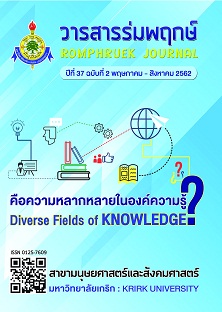The Syntactic Analysis and Comparison of Comparative Sentences Using Prepositions “bi” in Chinese and “Kwa” in Thai
Main Article Content
Abstract
The words “bi” and “Kwa” are the prepositions used frequently in Chinese and in Thai comparative sentences. This article aimed to analyze and compare the similarities and the differences of comparative sentence structures that use “bi” in Chinese and “Kwa” in Thai with the same syntax. This was in order to make the learners understand how to use them correctly. In terms of the basic sentence structure, the difference is in the placement of each word in sentences. According to the Thai comparative sentence structure, the sentence pattern is “Subject+ the word that shows comparison (Verb or Adjective)+Kwa+Objective”. In Chinese, on the contrary, the basic comparative sentence structure is “Subject + bi + Objective + the word that shows comparison (Verb or Adjective)”. Basically if there are phrases or words that are related to the quantity or numbers in Chinese se ntences, they are often placed after adjectives or verbs, but in Thai comparative sentence structure, they are placed after the objectives or verbs. If there are adverbs such as “hai” or “geng” In Chinese sentence structure, these words are always placed in front of the verb or the adjective. In Thai comparative sentence structure, on the other hand, the word “ยิ่ง” will be placed after the verb or adjective, for “ยัง” is placed in front of the verb or the adjective. In Chinese comparative sentence, when one use the verb as predicate, the adverbs such as zao เช้า / wan สาย / duo มาก / shao น้อย etc. are always placed in front of the verb. Whereas in Thai comparative sentence, the adverbs เช้า / สาย / มาก / น้อย will be put behind the verb. However, the placing of the word “de" (ได้) in Chinese sentence can be placed in two different places, for example, “wo bi ni pao de kuai” or “wo pao de bi ni kuai” and the meaning remain the same. However, the placing of the word “de" (ได้) at different places in the comparative sentence will have different points of emphasis. That is to say, in the first sentence, it emphasizes the difference of the things compared. In the second sentence, it emphasizes the degree of the predicate which cannot be found in Thai comparative sentence.
Article Details
Every article published in the Romphruek Journal of the Humanities and Social Sciences is the opinion and point of view of the authors. Thery're not the viewpoint of Krirk University or the editored department. Any part or all of the articles for pablication must be clearly cited.
References
เกรียงไกร กองเส็ง. (2559). การศึกษาเปรียบเทียบโครงสร้างและการใช้คำกริยาในภาษาจีนและภาษาไทย. (14 ธันวาคม 2561) สืบค้นจาก https://www.tcithaijo.org/index.php/jlpru/article/view/60918/50283.
นิตยา กาญจนะวรรณ. (2554). การวิเคราะห์โครงสร้างภาษาไทย. กรุงเทพฯ : สำนักพิมพ์มหาวิทยาลัยรามคำแหง.
ตรัยภรณ์ เกษมเปรมจิต. (2561). การศึกษาเปรียบเทียบประโยคเปรียบต่าง. กรุงเทพฯ : บัณฑิตวิทยาลัยจุฬาลงกรณ์มหาวิทยาลัย.
วิจินตน์ ภาณุพงศ์. (2520). โครงสร้างภาษาไทยระบบไวยากรณ์. กรุงเทพฯ : สำนักพิมพ์มหาวิทยาลัยรามคำแหง.
ศรีวิไล พลมณี. (2545). พื้นฐานการสอนภาษาไทยในฐานะภาษาต่างประเทศ. กรุงเทพฯ : สำนักพิมพ์แห่งจุฬาลงกรณ์มหาวิทยาลัย.
ศุภชัย แจ้งใจ. (2552). ปัจจัยที่ส่งผลต่อการเรียนภาษาจีนผู้เรียนสาขาวิเทศธุรกิจจีนและสาขาจีนศึกษา
คณะวิเทศศึกษามหาวิทยาลัยสงขลานครินทร์วิทยาเขตภูเก็ต. (17 กุมภาพันธ์ 2562) สืบค้นจาก
http://www.fis.psu.ac.th/jis_file/res_project/2010_supachai.pdf.
สุธินี สุขตระกูล. (2526). วิธีวิเคราะห์และเปรียบเทียบภาษา. กรุงเทพฯ : มหาวิทยาลัยธรรมศาสตร์.
เหยิน จิ่งเหวิน. (2555). ไวยากรณ์ภาษาจีนฉบับเปรียบเทียบ. กรุงเทพฯ : สำนักพิมพ์อมรินทร์.
อุปกิต ศิลปสาร, และ พระยา. (2514). หลักภาษาไทย. กรุงเทพฯ : ไทยวัฒนาพานิช.
Che, J. (2005). Xian dai han yu bi jiao ju lun lue . Bo Shi Lun Wen Hubei Normal University, Huangshi.
车竞. (2005). 现代汉语比较句论略. 博士论文. 湖北师范大学, 黄石.
Chen, K. (2014). Han tai bi jiao ju yu yi he yu yong dui bi fen xi .
Shuo Shi Lun Wen Yunnan Normal University, Kunming.
陈凯. (2014). 汉泰比较句语义和语用对比分析. 硕士论文. 云南师范大学, 昆明.
Di Pietro, Robert J. (1970). Language Structures in Contrast. Georgetown University, Wash-ington , D.C.
Liu, S. (2009). Xian dai han yu bi zi ju de ju fa yu yi yu yong fen xi . Bo Shi Lun Wen Inner Mongolia Normal University, Hohhot.
刘飒. (2009). 现代汉语 “比” 字句的句法、语义和语用分析. 博士论文. 内蒙古师范大学, 呼和浩特.
Liu, X.L. (2011). “Bi” zi ju zai dui wai han yu zhong de jiao yu xue . Modern Language , 2011(5), 127-128.
刘晓玲. (2011). “比” 字句在对外汉语中的教与学. 现代语文, 2011(5), 127-128.
Qi, H.Y. (2005). Dui wai han yu jiao xue yu fa . Shuo Shi Lun Wen Fudan University, Shanghai.
齐沪扬. (2005). 对外汉语教学语法. 硕士论文. 复旦大学, 上海.
Whitman, Rangal L. (1970). Contrastive Analysis; Problem and Procedures . Language Learning Research Club University of Michigan, Michigan.


